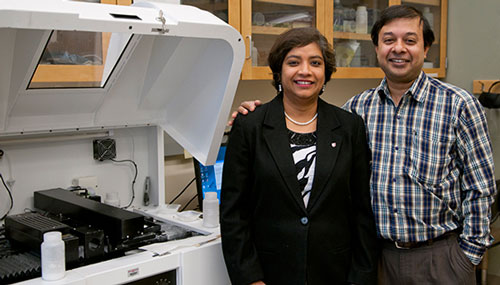| Jun 27, 2013 |
Researchers help launch 3-D printing into space
|
|
(Nanowerk News) Researchers at Washington State University are working with Aerojet Corporation on an exploratory project to make custom satellite parts using 3-D printing. Lower costs, less waste, quicker turnaround and easier modification are some potential benefits.
|
|
Amit Bandyopadhyay and Susmita Bose, professors in the School of Mechanical and Materials Engineering, will work on printing metal and ceramic components for low-volume manufacturing of a miniature research satellite. About the size of a coffee cup, it holds the world’s smallest liquid rocket engine.
|
 |
| Susmita Bose, left, and Amit Bandyopadhyay with 3-D printer.
|
|
3-D printing allows creation of objects directly from computer-aided design (CAD) models. Material is heated using a laser and is printed out layer by layer like melted candle wax into a desired shape.
|
|
Although Aerojet has been interested in additive manufacturing (another name for 3-D printing), the company has been concerned about meeting design specifications for attributes like strength, uniformity and brittleness.
|
|
"You can imagine that you want to print an airplane structure, but you have to prove that it’s good,’’ said Christian Carpenter, program manager at Aerojet. "The pieces have to work every time - and many of them for long periods.’’
|
|
He said he anticipates WSU will help the company develop parts that work every time. The researchers plan to co-author a paper on the project.
|
|
Bandyopadhyay and Bose are well known for 3-D printing of bone-like materials for orthopedic implants. With support from NASA, they also have demonstrated the possibility of printing 3-D objects from moon rock regolith (dust, soil and rock bits).
|
|
The researchers received support to work with Aerojet from Washington’s Joint Center for Aerospace Technology Innovation (JCATI). The 2012 Washington State legislature established JCATI to pursue joint industry-university research that can be used by aerospace firms.
|
|
"We believe that additive manufacturing could mean lower cost parts due to no tooling, no set up and little rejected material,’’ said Carpenter. "This could shorten our schedules for small quantity parts.’’
|
|
Parts could also be more easily modified than with traditional manufacturing techniques.
|
|
"It enables us to look at new designs that we really can’t build any other way,’’ Carpenter said. "This work is a necessary step that allows us to validate 3-D printing technology for space systems.
|
|
"Whether the project successfully produces parts or not, we’re going to learn something valuable,” he said. "I have no doubt that we’re going to find an application for this manufacturing process that provides significant benefit.’’
|

